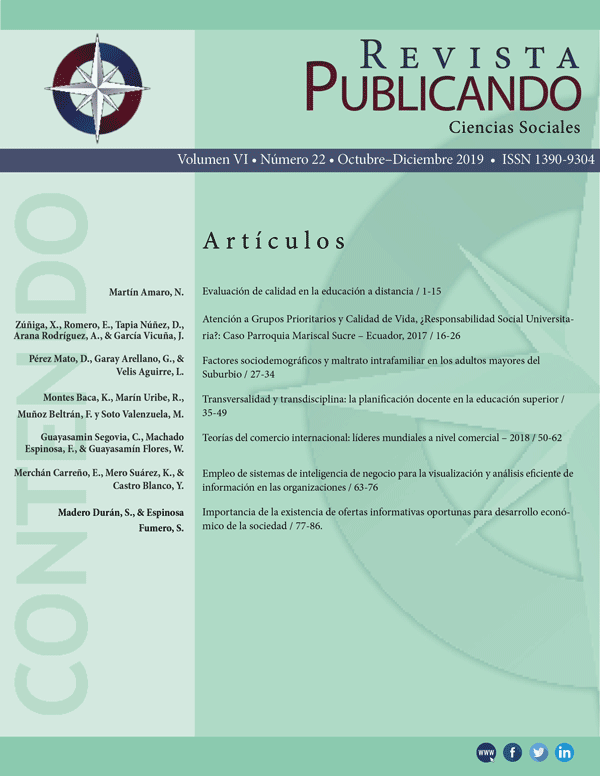Abstract
University social responsibility is an issue of high relevance and actuality. In Latin America and especially in Ecuador, it represents a contribution to the development of communities with less possibility of development. In the Ecuadorian case, the Laws of Higher Education establish it as an obligation, to demonstrate the formation of capable, ethical and responsible professionals, committed to the society to which they belong. The research presented was carried out to fulfill the objective of analyzing university social responsibility and its impact on the quality of life for priority care groups (children and adolescents) of the population of Mariscal Sucre parish (Milagro), located in Zone 5-Ecuador. Reaching the set objective required the application of a descriptive and explanatory methodology, focusing the study on the application of the technique of the survey questionnaire; after that, it was worked with a finite population, and it was obtained a probabilistic sample. The data collected gave way to the analysis to conclude that universities have the responsibility to contribute to the society through programs and projects that generate a contribution to the social needs that afflict it, in this case, those related to children and adolescents. However, the work being carried out does not take base on a study that specifies which are the most important social needs that must be addressed around contributing to the quality of life of vulnerable groups, in this case, children and teenagers who have not reached an essential development.
References
Adrila, R. (2003). Calidad de vida: una definición integradora. Redalyc. Recuperado de http://www.redalyc.org/pdf/805/80535203.pdf
ígora Democrática. (2009, agosto). La Constitución en la Práctica. Recuperado de http://www.activate.ec/estadisticas/docs/constitucion-practica/La-Constitucion-en-la-Practica-Cartilla-6.pdf
Arrioja, G., Pérez, E., Nava, V., y Moreno Tochihutl, M. (2009). Grupos Vulnerables. Recuperado de http://148.228.165.6/PES/fhs/Dimension Educacion para la salud/Grupos vulnerables.pdf
Asamblea Nacional de la República del Ecuador. (2008, 20 de Octubre). Constitución de la República del Ecuador. Recuperado de http://www.asambleanacional.gob.ec/sites/default/files/documents/old/constitucion_de_bolsillo.pdf
Coral, C. A., Chávez, M. E., y Fernández, C. (2018). Economía social : Sumak Kawsay y empoderamiento de la mujer. Espacios 39, (32), p. 34. Recuperado de http://www.revistaespacios.com/a18v39n32/a18v39n32p34.pdf
Díaz Caravantes, R. (2018). Vulnerabilidad y riesgo como conceptos indisociables para el estudio del impacto del cambio climático en la salud. Región Y Sociedad, 30(73). https://doi.org/10.22198/rys.2018.73.a968
Ecuador en Cifras. (2017). Instituto Nacional de Estadísticas y Censos. Recuperado de http://www.ecuadorencifras.gob.ec/documentos/web-inec/Sitios/LIBRObuenvivir/files/assets/downloads/page0032.pdf
Espinoza Santeli, G., y Guachamín Montoya, M. (2015, 3 de septiembre). La responsabilidad social universitaria en Ecuador. (U. A. Bolívar, Ed.) Recuperado de http://repositorio.uasb.edu.ec/bitstream/10644/5473/6/03-ES-Espinoza-Guachamin.pdf
EUROsociAl . (2015, abril). EUROsociAL. Recuperado de programa para la cohesión social en américa latina: www.eurosocial-ii.eu.
García , J., y Arana, A. (2017). Los grupos de atención prioritaria y su relación con la calidad de vida de la población de la parroquia de Mariscal Sucre. (F. d. Comerciales, Ed.) Recuperado de http://repositorio.unemi.edu.ec/handle/123456789/3551.
Garzón Zuñiga, A. C. (2016). El acceso a la salud de los grupos de atención prioritaria y el principio constitucional de igualdad real y formal. Recuperado de http://repo.uta.edu.ec/handle/123456789/18024
Guerrero-R, N., y Yépez-Ch, M. (2015). Factores asociados a la vulnerabilidad del adulto mayor con alteraciones de salud. Universidad y Salud, 17(1), 121–131. Recuperado de http://www.scielo.org.co/pdf/reus/v17n1/v17n1a11.pdf
Instituto Nacional de Estadísticas y Censos. (2017). Encuesta Nacional de Empleo, Desempleo y Subempleo-Indicadores de pobreza y desigualdad. Recuperado de https://www.ecuadorencifras.gob.ec/documentos/web-inec/POBREZA/2017/Junio/062017_Pobreza%20VF.pdf
Larrán, J., y Andrades, F. (2015). Análisis de la responsabilidad social universitaria desde diferentes enfoques teóricos. Revista Iberoamericana de Educacion Superior, 6(15), 91–107. Recuperado de https://doi.org/10.1016/S2007-2872(15)30005-6
Ministerio de Trabajo de Ecuador. (2016). Dirección de Atención a Grupos Prioritarios: Rendición de cuentas 2016. Recuperado de http://www.trabajo.gob.ec/wp-content/uploads/2017/05/GRUPOS-PRIORITARIOS.pdf
Pérez Serrano, G., y De-Juanas Oliva, í. (2013). Calidad de vida en personas adultas y mayores. Recuperado de https://books.google.com.ec/books?id=2j22AwAAQBAJ&printsec=frontcover&hl=es&source=gbs_ge_summary_r&cad=0#v=onepage&q&f=false
Ruiz, N. (2011). La definición y medición de la vulnerabilidad social. Un enfoque normativo.Investigaciones Geográficas, Boletín del Instituto de Geografía. UNAM, (77), 63-74.
Vallaeys, F. (2014). La responsabilidad social universitaria : un nuevo modelo universitario contra la mercantilización. Revista Iberoamericana de Educación Superior 12, 105–117. Recuperado de https://doi.org/10.1016/S2007-2872(14)71945-6
Vásquez Paredes, G. P. (2015). Trabajo protegido de adolescentes: un reto para la política pública del Ecuador. Buenos Aires: CLACSO.
You are free to:
Share — copy and redistribute the material in any medium or format.
Adapt — remix, transform, and build upon the material.
The licensor cannot revoke these freedoms as long as you follow the license terms.
Under the following terms:
Attribution — You must give appropriate credit, provide a link to the license, and indicate if changes were made. You may do so in any reasonable manner, but not in any way that suggests the licensor endorses you or your use.
NonCommercial — You may not use the material for commercial purposes.
ShareAlike — If you remix, transform, or build upon the material, you must distribute your contributions under the same license as the original.
No additional restrictions — You may not apply legal terms or technological measures that legally restrict others from doing anything the license permits.
